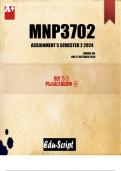MNP3702
ASSIGNMENT 5 SEMESTER 2 2024
UNIQUE NO.
DUE 17 OCTOBER 2024
, Introduction
The Foschini Group (TFG), a leading South African retail company, has taken
considerable strides in integrating the United Nations Sustainable Development Goals
(SDGs) and the 2030 Agenda for Sustainable Development into its supply chain. By
focusing on the Balanced Scorecard (BSC), which evaluates performance from four
perspectives—financial, customer, internal processes, and learning and growth—TFG is
working towards addressing social, environmental, and economic challenges. This
integration has helped TFG not only improve its sustainability efforts but also enhance
the overall performance and efficiency of its supply chain. The BSC provides a well-
rounded approach for TFG to manage its sustainability initiatives while linking them to
the relevant SDGs.
Diagram: Balanced Scorecard for TFG's Supply Chain Performance
[Illustrate the Balanced Scorecard (BSC) diagram with the four perspectives – Financial,
Customer, Internal Processes, Learning & Growth – and show how each relates to
specific SDGs relevant to TFG’s supply chain.]
I will now discuss each of the four perspectives of the Balanced Scorecard and show
how they link to the SDGs, highlighting real examples from TFG's Sustainability Report.
Balanced Scorecard Application
1. Financial Perspective
The financial perspective focuses on profitability, cost management, and revenue
growth. For TFG, financial performance is crucial because it ensures the business’s
long-term viability. To align with the SDGs, TFG has made efforts to reduce costs while
simultaneously incorporating sustainable practices.
Example:




